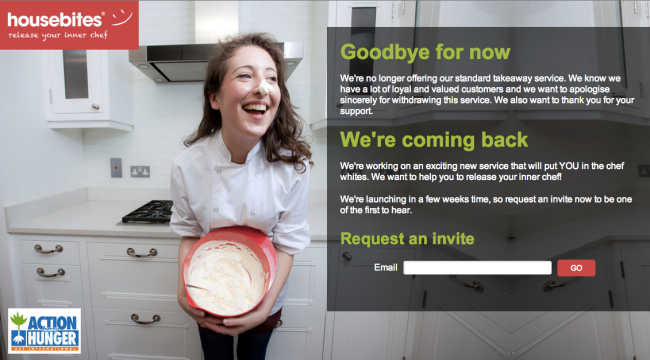It has just emerged that Housebites, a peer to peer startup nicknamed the “Airbnb for take-out”, is revising its business model and will be launching a new website soon. Housebites launched in 2010 and allowed independent chefs to sell their cooked food as a takeaway service, and their site has been replaced with a message saying “Goodbye for now” with a few hints of what is to come.

Housebites is one of a string of peer to peer networks that has run into trouble recently. Last month Gidsy, a peer to peer service for activities and things to do, announced that it was moving to GetYourGuide, a larger, older, B2C organisation. Only last week, Airbnb was in the news for being ‘illegal’ in New York, as New York and indeed many cities do not allow people to sub-let their apartments for short leases. There are a lot of grey areas in what Airbnb does – or what it allows and encourages its users to do – and now that the company is big enough to be heard of by everyone and their mum, the legal cases are beginning.
So is the peer to peer model broken?
The model isn’t necessarily broken but it appears very difficult to scale these companies successfully, as they centre around unique experiences. How unique can these experiences be once they are on a huge scale? And how can these companies assess and guarantee the quality of so many experiences? The companies need to be incredibly tightly-managed, and ideally have people on board who can negotiate legalese and provide suitable answers when probed on these grey areas.
The P2P startups also sometimes have a hard time securing funding because, as was the case for Housebites, they are not considered ‘techy’ enough. Their propositions centre on humans, which isn’t always appealing enough to attract venture capital.

What about the communities these companies are leaving behind?
There are a lot of lost people left over after the storm. The chefs who sold their creations through Housebites have created their own Facebook group and Twitter feed called Hungry Chefs (and they are pretty vocal at the moment), and many users of Gidsy were rather shocked when the announcement appeared suddenly on the website (above). Indeed, many of those users might not be interested to use GetYourGuide as the proposition is entirely different, although both revolve around finding things to do. So what will these users do? Those hoping to run collaborative movements will certainly have a lot of work to do, in trying to maintain momentum and the smooth running of these operations. But they are feeling positive about the future. I spoke to the spokesperson for Hungry Chefs, who told me:
“We are collaborating to see if we can build on the things we learned – good and bad – from the Housebites experience. Our aim is to use social media and mobile payment technology in the early stages as we think the platform should be secondary to fantastic food.
It should be possible resume delivery of great, home–cooked chef meals to foodies. As a collective, we will also be looking at ways to group all sorts of chefs under the Hungry Chefs banner to find meaningful work and opportunities outside of the restaurant kitchen.”
Overall we can only hope that these initiatives, as well as other P2P startups (anything that gets called “the Airbnb for _______”), are successful. Personally, I think that Gidsy, Airbnb and Housebites all have or had fantastic visions that a lot of people are passionate about, and it’s painful seeing such positivity get dragged down by red tape, lack of scaleability and lack of funding or income. Perhaps in 10 years the P2P model will have been cracked, and these companies will be celebrated as the pioneers.




